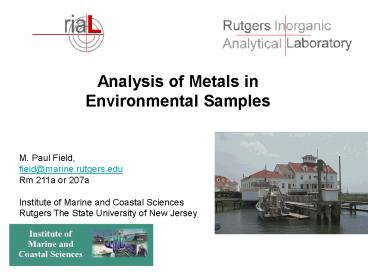Analysis of Metals in Environmental Samples - PowerPoint PPT Presentation
1 / 32
Title:
Analysis of Metals in Environmental Samples
Description:
Institute of Marine and Coastal Sciences. Rutgers The State University of ... Mercury poisoning results in weakness, loss of appetite, insomnia, indigestion, ... – PowerPoint PPT presentation
Number of Views:134
Avg rating:3.0/5.0
Title: Analysis of Metals in Environmental Samples
1
Analysis of Metals in Environmental Samples
M. Paul Field, field_at_marine.rutgers.edu Rm 211a
or 207a Institute of Marine and Coastal
Sciences Rutgers The State University of New
Jersey
2
Metals
3
Outline
- Trace Metals 1
- Data quality
- Precision
- Accuracy
- Calibration
- Sample preparation
- Trace Metals 2
- FAA
- GFAA
- ICP-OES
- ICP-MS
- Generate real data
4
Precision
5
Standard deviation
1 Std 68.2 2 Std 95.5 3 Std 99.7
6
Error propagation ( -)
Uncertainty Absolute Relative
7
Error propagation (x /)
Convert absolute to percent
8
Significant figures
Uncertainty defines significant figures
Concentration of Pb In drinking water 0.01
ppm 0.013 ppm 0.0127 ppm 0.01267 ppm
9
Quantification
- Semi quant
- External standards
- External standards with Internal standard
- Standard Additions
- Isotope Dilution
10
Making Standards
11
Making a calibration
12
Linear best fit
13
Calculating least squares
14
Determining slope and Intercept
15
Linear best fit
16
Std of slope and intercept
Sy is the deviation of several vertical deviations
17
Making a calibration
18
Calibration uncertainty
19
Calibration uncertainty
n number of data points in standard curve k
number of replicates of unknown
20
Making a calibration
21
Accuracy
22
Internal standard
23
Certified reference materials
24
Certified reference materials
25
Students t
26
Class project
- The Standard is the tape measure.
- Create a standard curve with measurements using
any body part. - Replicate measurements of standards.
- Measure unknowns (several replicates)
- Measure CRM
- Express results with appropriate significant
figures, precision and accuracy
27
Metals of interest
Health Effects The health effects related to
consumption of several metals are presented
below. Keep in mind that research is still being
conducted on the toxicity of most of these
elements. Consult with a physician if your water
contains metals and you suspect health problems
related to metal consumption. Arsenic is
widespread in the environment due to its natural
occurrence and former extensive use in
pesticides. Symptoms of chronic arsenic poisoning
are weight loss, hair loss, nausea, white lines
across the toenails and fingernails, depression,
and general fatigue. Cadmium poisoning has
been associated with kidney disease,
hypertension, and possibly genetic mutation.
Chromium may cause lung tumors when inhaled and
has adverse effects on aquatic life. Copper
in large doses is dangerous to infants and people
with certain metabolic disorders. On the other
hand, lack of copper intake causes anemia, growth
inhibition, and blood circulation problems.
Iron in water is not a health hazard by itself
but it may increase the hazard of pathogenic
organisms, since many of these organisms require
iron to grow. Lead is a cumulative poison,
meaning that it remains in the body following
exposure. Children under age three are most
susceptible to lead poisoning. Minor symptoms
include abdominal pains, decreased appetite,
constipation, fatigue, and decreased physical
fitness. Long-term exposure may cause kidney
damage, anemia, nerve and brain damage, and
death. Mercury poisoning results in weakness,
loss of appetite, insomnia, indigestion,
diarrhea, gum inflammation, loosening of the
teeth, irritability, memory loss, muscle tremors,
and brain damage following large doses.
28
Trace metals
- Acid cleaning
- Filtration
- Acidification
- Dilution
- Internal standard
29
Parts per million and billion
30
(No Transcript)
31
(No Transcript)
32
(No Transcript)































